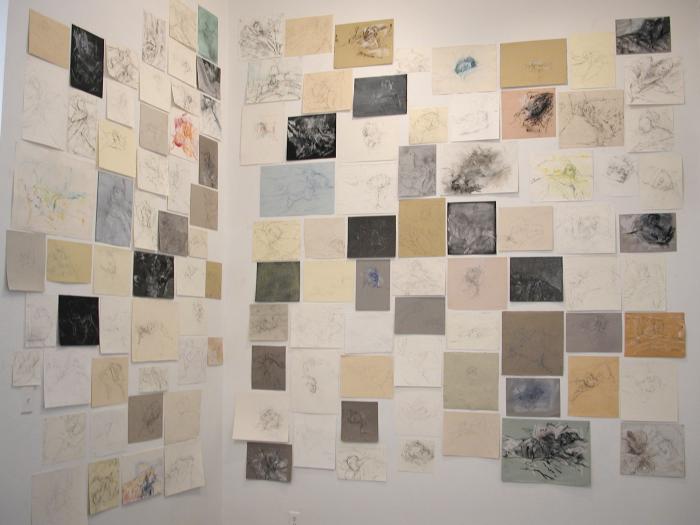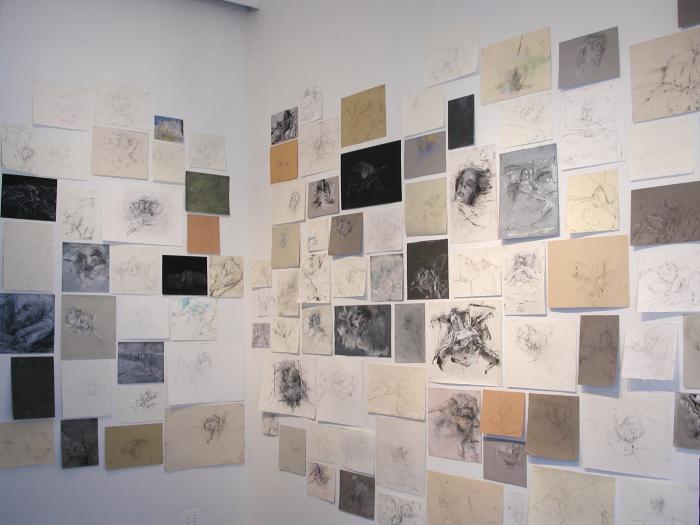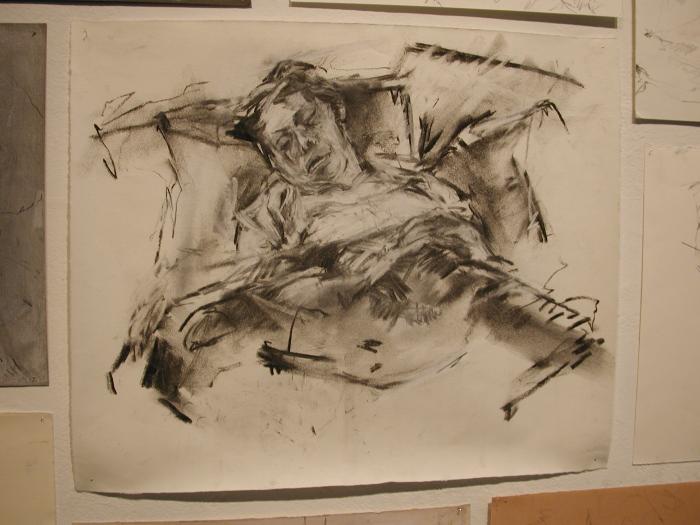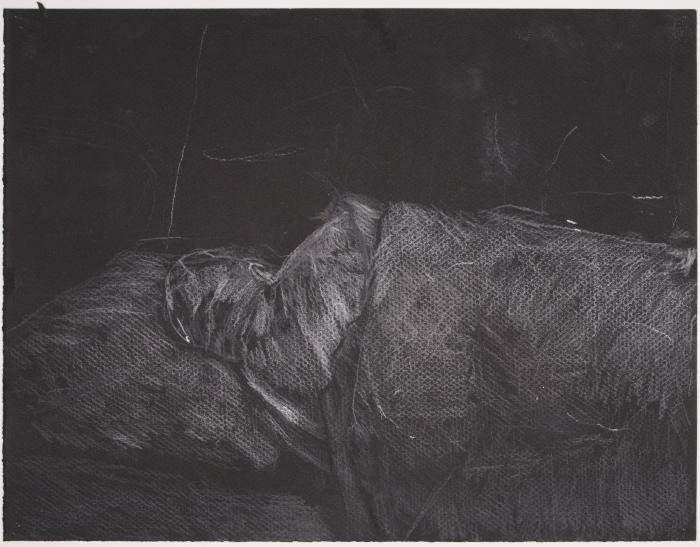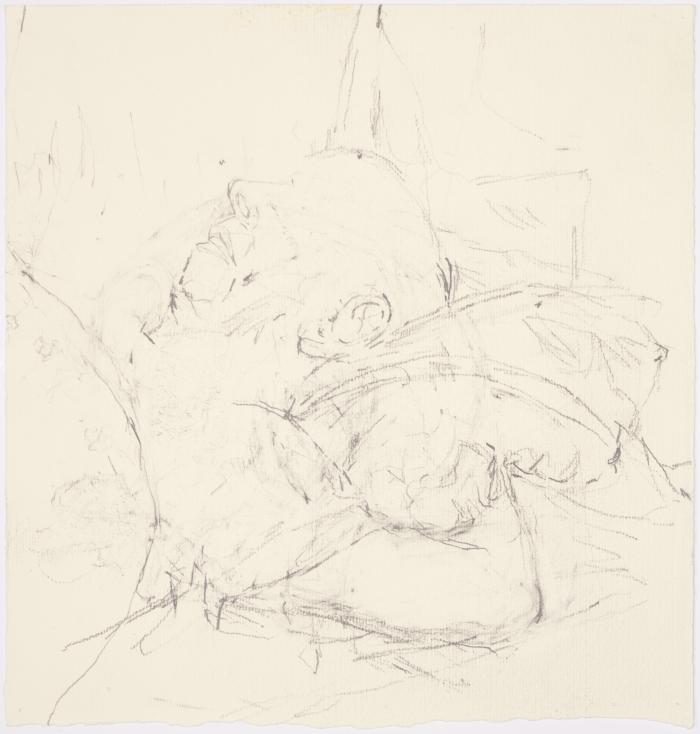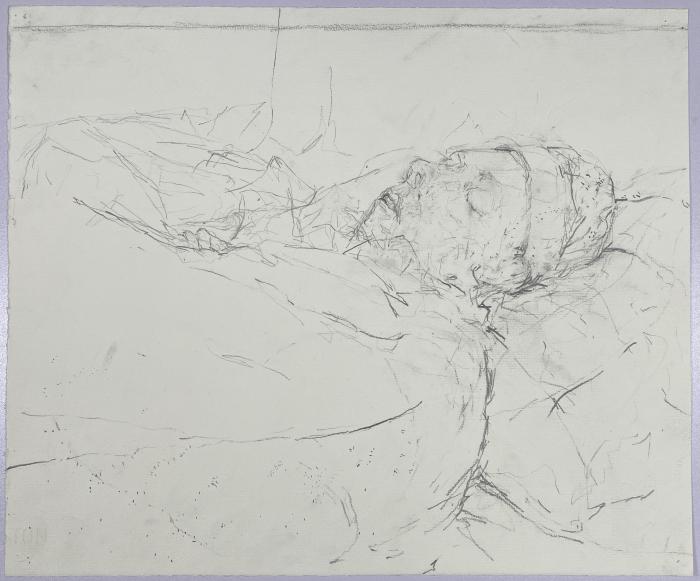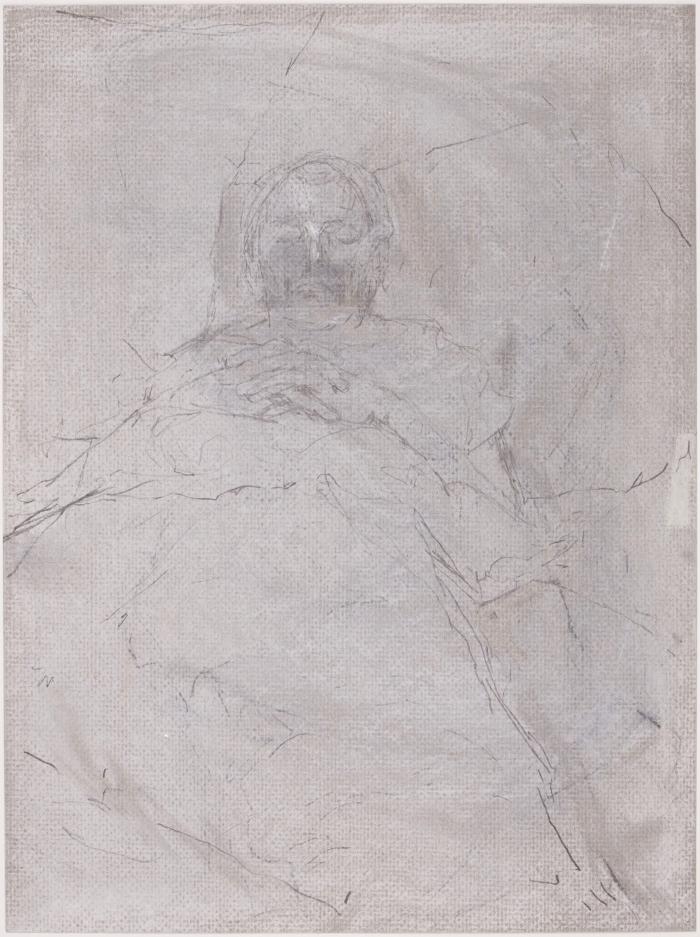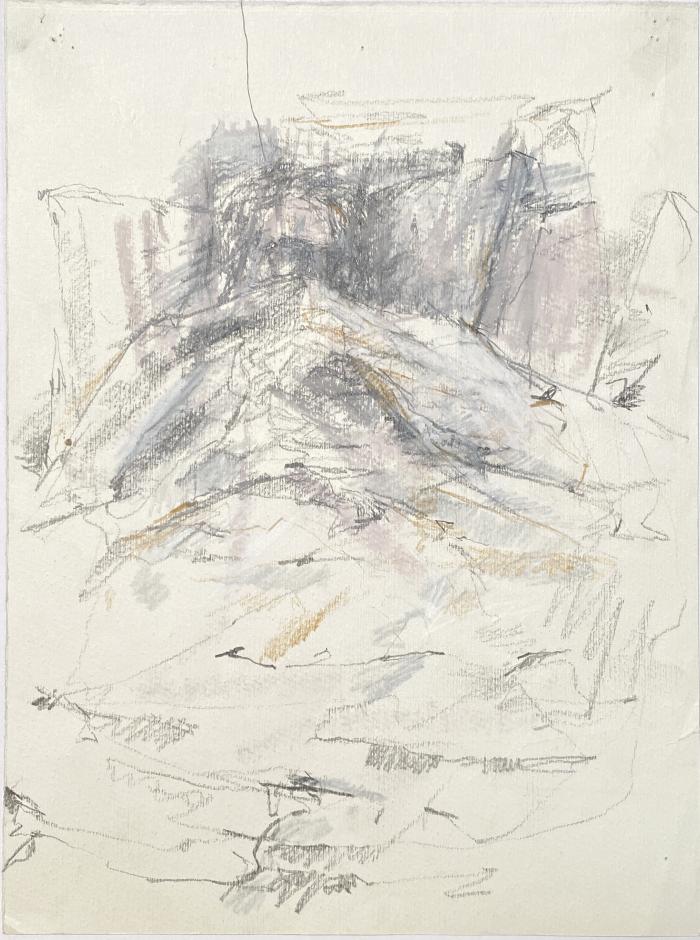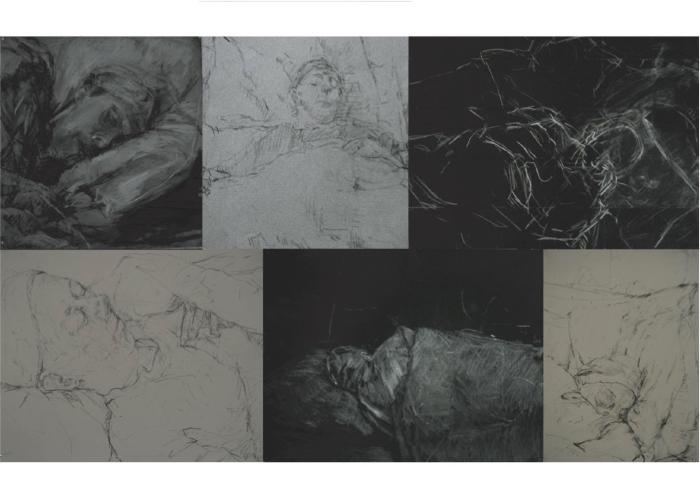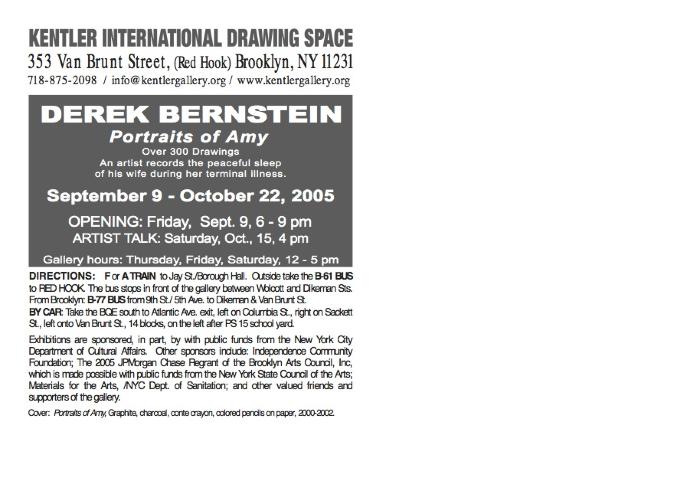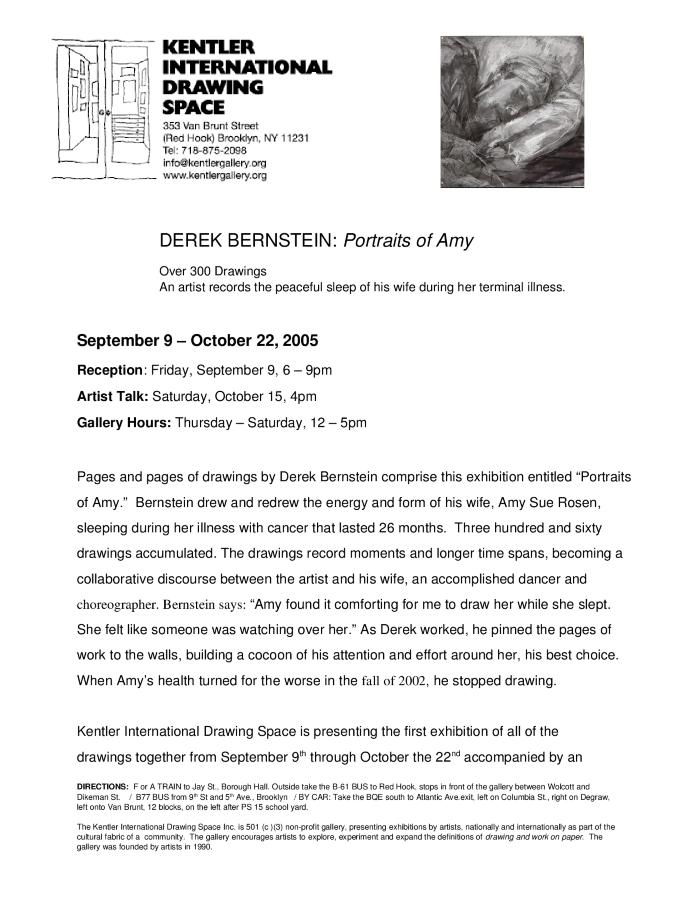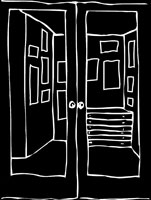exhibition
Derek Bernstein, Portraits of Amy
Date
September 9 – October 22, 2005Opening Reception
September 9, 2005Artist
Derek Bernsteinexhibition Images
Click to Enlarge.
Press and Promotion
About the exhibition
Derek Bernstein, Portraits of Amy
September 9 - October 22, 2005
Artist's Talk: October 15, 2005
Far from me and like the stars, the sea and all the trappings of poetic myth,
Far from me but here all the same without your knowing,
Far from me and even more silent because I imagine you endlessly.
Far from me, my lovely mirage and eternal dream, you cannot know.
If you only knew.
Far from me and even farther yet from being unaware of me and still unaware…
"If you only knew" by Robert Desnos (1900-1945)
Random acts of scraping, scratching, scribbling and scrawling are wild gestures or elemental actions like a primal scream or a cry to communicate as a child attempts to speak. Such actions could be a fundamental means of tracing out a form or space as an animal marks its home territory. A multitude of marks incised on a surface whether they are rocks, sand, paper, skin or plaster have recorded over the centuries man’s engagement and emotional response to his environment. These gestures are either impulsive or premeditated, which can transpose into symbols in which realm the origin of language lies. At the same time, mark making continues to endure as the act of drawing describes form, time and space. Drawing by artists of the twenty first century is something of an anomaly in this age of digital photography and prints. Nevertheless, drawing has persisted and it has in fact broadened its status from being a minor support medium to that of a major expressive and distinctive one in the last thirty years.
Drawings vary enormously with media and substrate and traditionally are divided into two basic areas; preparatory studies that are eventually transposed into another media or those that are complete in themselves. However studies or unfinished drawings considered incomplete in the past now often take on a new status of finality, depending on the context in which they are presented. This state of incompleteness can in fact generate a sense of urgency and intimacy that reflects an intuitive experience. A subconscious poetic act is rendered as the Surrealists realized with their automatic writing. Fragments of marks can congeal and dissipate scattering across the page to suggest transitory moments as text has done in poetry since Stéphane Mallarmé.
Confinement forces one to reflect on the minutiae of time and memory, which in turn expands into unknown areas. The personal struggles of those who have undergone such conditions through torture, illness or self-imposed penance have been recorded on multiple occasions spiritual texts and literary works have left a vivid impression of how the mind expands space when the actions of the body are restricted such as those of Marcel Proust. Think also of Jean-Dominique Bauby bedridden in a coma that authored Butterfly and the Diving Bell by blinking only his eyes. On the other hand observing this state of being and engaging with an individual in these situations possess a very different form of understanding and interaction with the space and individual.
Derek Bernstein's drawings address this condition of isolation responding to it in a self-imposed confinement in a room that shelters a bedridden figure, which he confronts daily. He draws and redraws this form, which stirs restlessly in front of him. His efforts are undertaken sometimes for only minutes other times for hours often in the middle of the night or early dawn hours. Compulsively he works in a multitude of ways with no regard for any formality. His medium and paper frequently varies drawing on whatever is available using anything from pencils to chalks to crayons in black and white or colour. Each time Bernstein tackles in his subject he is presented with a new challenge. On occasions fleeting marks dance across the page other times heavy strokes crisscross densely forming a volume, a head perhaps with the face barely recognizable. He performs with a subconscious dexterity, producing portraits of a sort that are captured in this manner formed and reformed cross-hatched, marked and stroked. Capturing minute gestures of the body in front of him Bernstein draws and redraws the head as it tosses and turns which appears to be oblivious to his presence. These evolve day after day hour after hour as he produces over 400 drawings in 26 months. Each time he comes back to the subject he attempts to capture its essence anew and is compelled to repeat his actions without regard for the results. There is no assessment made, he moves on to the next rendition. He persists in his endeavour without thinking, not with a sense of dissatisfaction; there is no decision making, no judgment. There is no conscious effort to compose or to undertake a particular systematic approach, there is only a desire to continue and exercise his need to record these moments. There is a compulsion in which he goes on and on. He must go on as Samuel Beckett would say. These are records of time, not sequential time but fragments of time. Here time is both collapsed and expanded.
A multitude of artists over the centuries have approached the figure with similar perseverance. The portrait studies by other artists might not have been a conscious source of inspiration for Bernstein such as those of Leonardo or Rembrandt, however it is Giacometti’s working method that most closely approaches his. He similarly reworked his drawings month after month in order to render the essence of his sitter, as was his practice in sculpture and in painting. Giacometti, constantly formed and reformed the image in front of him reducing it to a skeletal form almost dematerializing it. The figure often stripped down to an elemental structure to such a degree that the surrounding space became an essential aspect of the work with the presence of the body hovering within it like a phantom. On the other hand, his portraits focus on the head and in particular the face. In these renditions the eyes stare out and peer through the skull, penetrating the space beyond from the void.
In Bernstein's case the void is internalized not an implied external space. In the bedroom a makeshift studio in which he feverishly works, the bedridden figure becomes enveloped within a cocoon of drawings. The walls progressively become filled with his drawn gestures, as he routinely pins each work up as he stops before starting again. Some are only quick sketches, others more laboured. Thus generating a portrait gallery -- salon style, as images are stacked one above the other and side-by-side. At this point, subject and images blend together.The focus, here is a frail female body lost in a bundle of blankets, sheets and pillows which is now echoed repeatedly throughout the space. These equally frail paper fragments hang without pretense recording his own endurance through many sleepless nights and his correspondence with this fragile human figure. This poetic gesture recalls the love poems of the Surrealist Robert Desnos in which he wrote in a sleep-deprived state of delirium in an attempt to reveal his emotions trapped within his subconsciousmind. Bernstein's drawings take on this quality, which are not grounded but float around the room in an ever-expanding way. This modest space in all its humility is now transposed into a monumental and sacred space. A fitting tribute by an artist, to his wife Amy Rosen, as she lay before him dying of cancer.
—Alastair R. Noble
Easton PA, 2005
